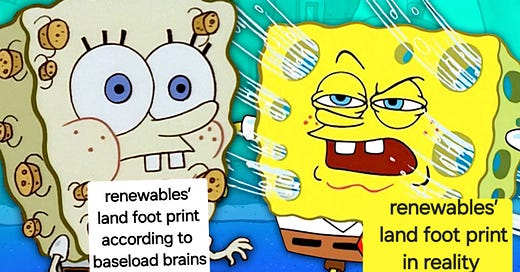Mediocre Metrics 4: Land footprint
Why land use isn't land use and why a balloon is 99.9% air and only 0.1% balloon.
In this edition of mediocre metrics, we look at land, its use, and how this can be misleading.
Definition
Let’s define:
Gross land use - land allocated to an (or multiple) activity. The most commonly used definition, for example you could point to an area on a map and highlight a field or solar farm and its boundaries.
Net land use - land which is actually covered by infrastructure, such as solar panels, turbine towers, substations and roads. One grey area is that often by law, lease contracts or compensation rights, land under overhead lines or area swept by turbine blades is also included even though it can have dual use, like a road or crop growing under it - so should that be excluded from net land use to not double count it?
Impervious surface - land that’s covered on surface level which prohibits plant growth or life in general, but also inhibits water run off.
It’s useful
to check total potential of an energy source given available land. For example, how much wind, solar, biofuels, etc. can be deployed in a given country.
to rule out certain technologies. If it takes orders of magnitude more land to use biofuels than direct electrification, it’s not just a no brainer, you might simply run out of land.
to allocate general area to energy production in spatial planning.
The north sea for instance requires careful allocation of space to offshore wind farms and cables to protect shipping routes, fishing grounds as well as conflicts with potential storage sites for carbon capture & storage (CCS).
Germany is looking to accelerate permitting by allocating renewables capacity targets to the states who then break it down to municipalities who have to find the space needed among living area, farming and other infrastructure.
A lot per plot or not?
Per unit area, biofuels don’t give you a lot of useful energy
It’s not useful
as a KPI among most already viable technologies. Similar to EROI, it serves little as a differentiator.
to allocate only one technology to a given area. Area is not simply “used up”. Just because you need a certain distance between turbines or panels doesn’t you can’t use the area between or below them. Easily demonstrated with
co-location of energy types like wind and solar,
co-location with agriculture, and
co-location with impervious surface especially solar on roofs, facades, parking lots etc.
It’s misused
to discredit renewables by using gross land foot print and equating that with impervious surfaces (e.g., tarmac) and hence being environmentally destructive.
to discredit renewables by claiming we don’t have enough land for renewables to meet demand.
A fishnet covers a certain area, but it’s largely gaps and a sponge uses a certain volume, but it’s mostly holes. Between renewables you can plant crops, have animals graze or even build more renewables. Better even, we have already used an insane amount of land for buildings or roads on which you can place more solar panels than we’d ever need.
But even then, we barely use any land for renewables anyway because we have a huge amount of it. We sit on a lot of land and could meet our needs many times over.
Sow the wind, reap the GWhs
Land use for wind and solar is marginal compared to that for meat production, highways, and especially biofuels. With minimal land use Germany reached 56.4% and the UK 55.7% of renewables as share of load already. While biofuel crops cover large parts of the Germany they “only” contribute 9.7% with a much less clear decarbonisation impact.
Source: left - Christian Victor1; right CarbonBrief2
Something we’d like you to look out for, next time you see a conservative politician complain about wind turbine using up space and should be built somewhere else, check if they support policies to subsidise farmers’ biofuel crops (and maybe also their fossil fuels).
Further reading
This read is a must on land use discussing in depth the non-existent threat of solar and agriculture: Factcheck: Is solar power a ‘threat’ to UK farmland? - Carbon Brief
Poorly translated illustration found here https://twitter.com/cvictordus/status/1791961219143766322






